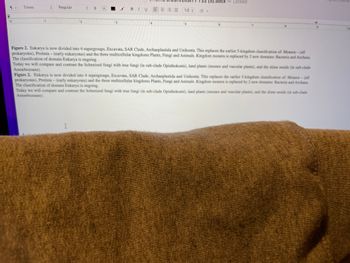Evolutionary Group(s) Refer to figure 2 on page 2 of the lab. What color(s) is/are this organism? Does it contain chlorphyll? Is there a "photosymbiont" present (refer to the lichens of Wisconsin guide) Describe the structure and composition of this organism - does it have leaves, roots, thallus, thizing, mycelia, fruiting bodies (etc.) How else might you distinguish this organism from another organism in this table Lichen Fungi Slime Mold Plants
Evolutionary Group(s) Refer to figure 2 on page 2 of the lab. What color(s) is/are this organism? Does it contain chlorphyll? Is there a "photosymbiont" present (refer to the lichens of Wisconsin guide) Describe the structure and composition of this organism - does it have leaves, roots, thallus, thizing, mycelia, fruiting bodies (etc.) How else might you distinguish this organism from another organism in this table Lichen Fungi Slime Mold Plants
Human Anatomy & Physiology (11th Edition)
11th Edition
ISBN:9780134580999
Author:Elaine N. Marieb, Katja N. Hoehn
Publisher:Elaine N. Marieb, Katja N. Hoehn
Chapter1: The Human Body: An Orientation
Section: Chapter Questions
Problem 1RQ: The correct sequence of levels forming the structural hierarchy is A. (a) organ, organ system,...
Related questions
Question

Transcribed Image Text:Evolutionary Group(s)
Refer to figure 2 on page 2 of
the lab.
What color(s) is/are this
organism? Does it contain
chlorphyll? Is there a
"photosymbiont" present
(refer to the lichens of
Wisconsin guide)
Describe the structure
and composition of this
organism - does it have
leaves, roots, thallus,
rhizine, mycelia, fruiting
bodies (etc.)
How else might you
distinguish this organism
from another organism
in this table
Lichen
Fungi
Slime Mold
Plants
Expert Solution
This question has been solved!
Explore an expertly crafted, step-by-step solution for a thorough understanding of key concepts.
Step by step
Solved in 2 steps

Follow-up Questions
Read through expert solutions to related follow-up questions below.
Follow-up Question
This should help with part 1 of the table, thank you

Transcribed Image Text:41
0
Times
1
C Regular
2
9
3
a BIU EEEE 1.0
5
(5).docx
6
Locked
7
8
Figure 2. Eukarya is now divided into 4 supergroups, Excavata, SAR Clade, Archaeplastida and Unikonta. This replaces the earlier 5-kingdom classification of: Monera - (all
prokaryotes), Protista - (early eukaryotes) and the three multicellular kingdoms Plants, Fungi and Animals. Kingdom monera is replaced by 2 new domains: Bacteria and Archaea.
The classification of domain Eukarya is ongoing.
Today we will compare and contrast the lichenized fungi with true fungi (in sub-clade Opisthokonts), land plants (mosses and vascular plants), and the slime molds (in sub-clade
Amoebozoans).
Figure 2. Eukarya is now divided into 4 supergroups, Excavata, SAR Clade, Archaeplastida and Unikonta. This replaces the earlier 5-kingdom classification of Monera - (all
prokaryotes), Protista - (early eukaryotes) and the three multicellular kingdoms Plants, Pungi and Animals. Kingdom monera is replaced by 2 new domains: Bacteria and Archaea.
The classification of domain Eukarya is ongoing.
Today we will compare and contrast the lichenized fungi with true fungi (in sub-clade Opisthokonts), land plants (mosses and vascular plants), and the slime molds (in sub-clade
Amoebozoans).
10
Solution
Knowledge Booster
Learn more about
Need a deep-dive on the concept behind this application? Look no further. Learn more about this topic, biology and related others by exploring similar questions and additional content below.Recommended textbooks for you

Human Anatomy & Physiology (11th Edition)
Biology
ISBN:
9780134580999
Author:
Elaine N. Marieb, Katja N. Hoehn
Publisher:
PEARSON

Biology 2e
Biology
ISBN:
9781947172517
Author:
Matthew Douglas, Jung Choi, Mary Ann Clark
Publisher:
OpenStax

Anatomy & Physiology
Biology
ISBN:
9781259398629
Author:
McKinley, Michael P., O'loughlin, Valerie Dean, Bidle, Theresa Stouter
Publisher:
Mcgraw Hill Education,

Human Anatomy & Physiology (11th Edition)
Biology
ISBN:
9780134580999
Author:
Elaine N. Marieb, Katja N. Hoehn
Publisher:
PEARSON

Biology 2e
Biology
ISBN:
9781947172517
Author:
Matthew Douglas, Jung Choi, Mary Ann Clark
Publisher:
OpenStax

Anatomy & Physiology
Biology
ISBN:
9781259398629
Author:
McKinley, Michael P., O'loughlin, Valerie Dean, Bidle, Theresa Stouter
Publisher:
Mcgraw Hill Education,

Molecular Biology of the Cell (Sixth Edition)
Biology
ISBN:
9780815344322
Author:
Bruce Alberts, Alexander D. Johnson, Julian Lewis, David Morgan, Martin Raff, Keith Roberts, Peter Walter
Publisher:
W. W. Norton & Company

Laboratory Manual For Human Anatomy & Physiology
Biology
ISBN:
9781260159363
Author:
Martin, Terry R., Prentice-craver, Cynthia
Publisher:
McGraw-Hill Publishing Co.

Inquiry Into Life (16th Edition)
Biology
ISBN:
9781260231700
Author:
Sylvia S. Mader, Michael Windelspecht
Publisher:
McGraw Hill Education